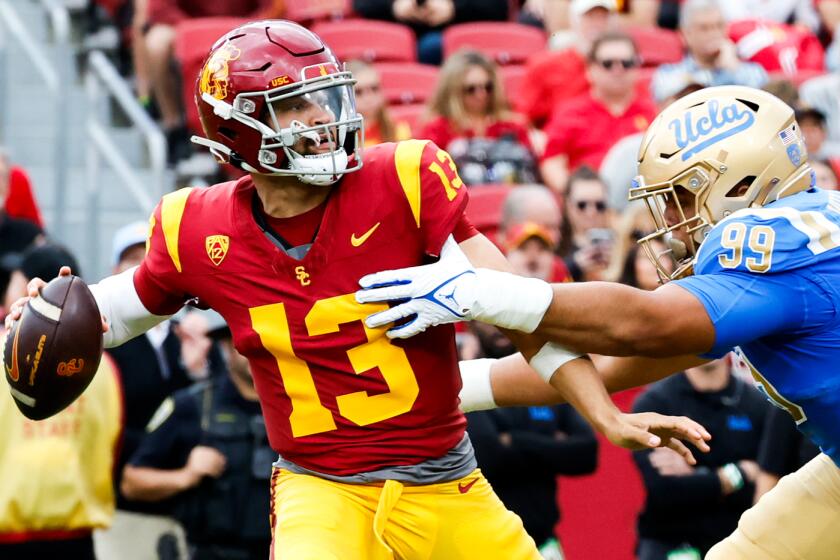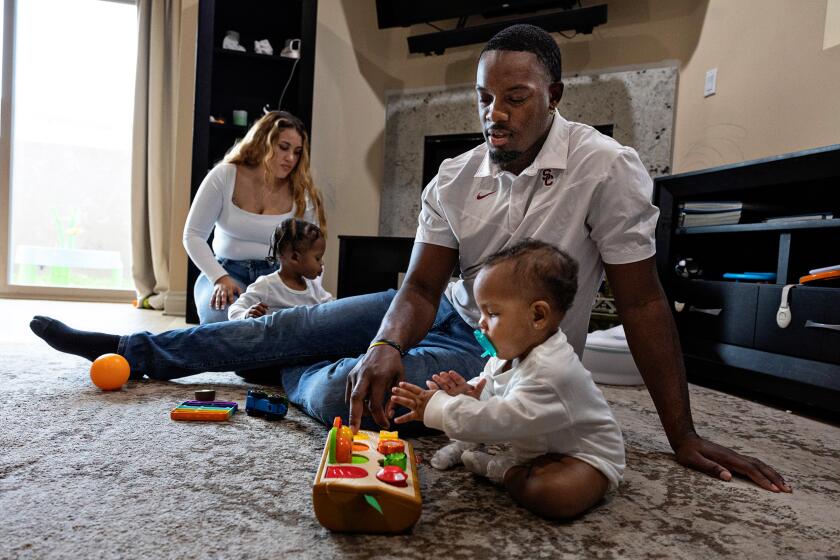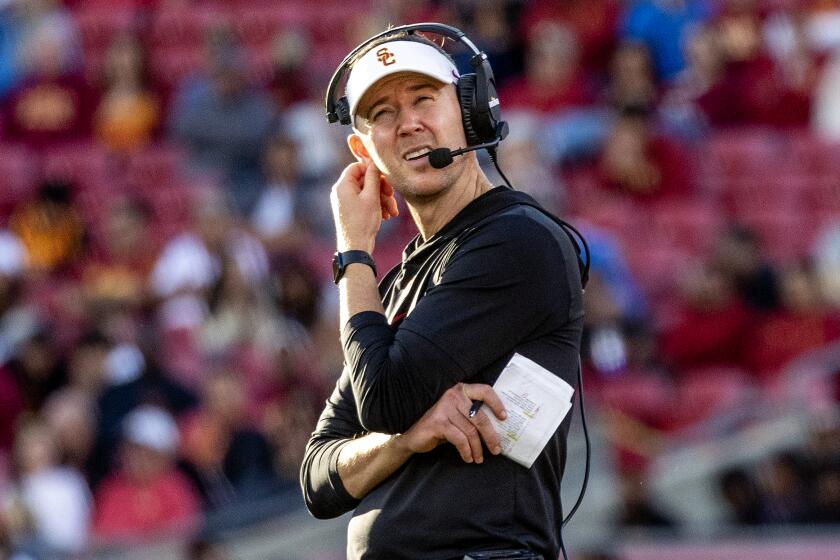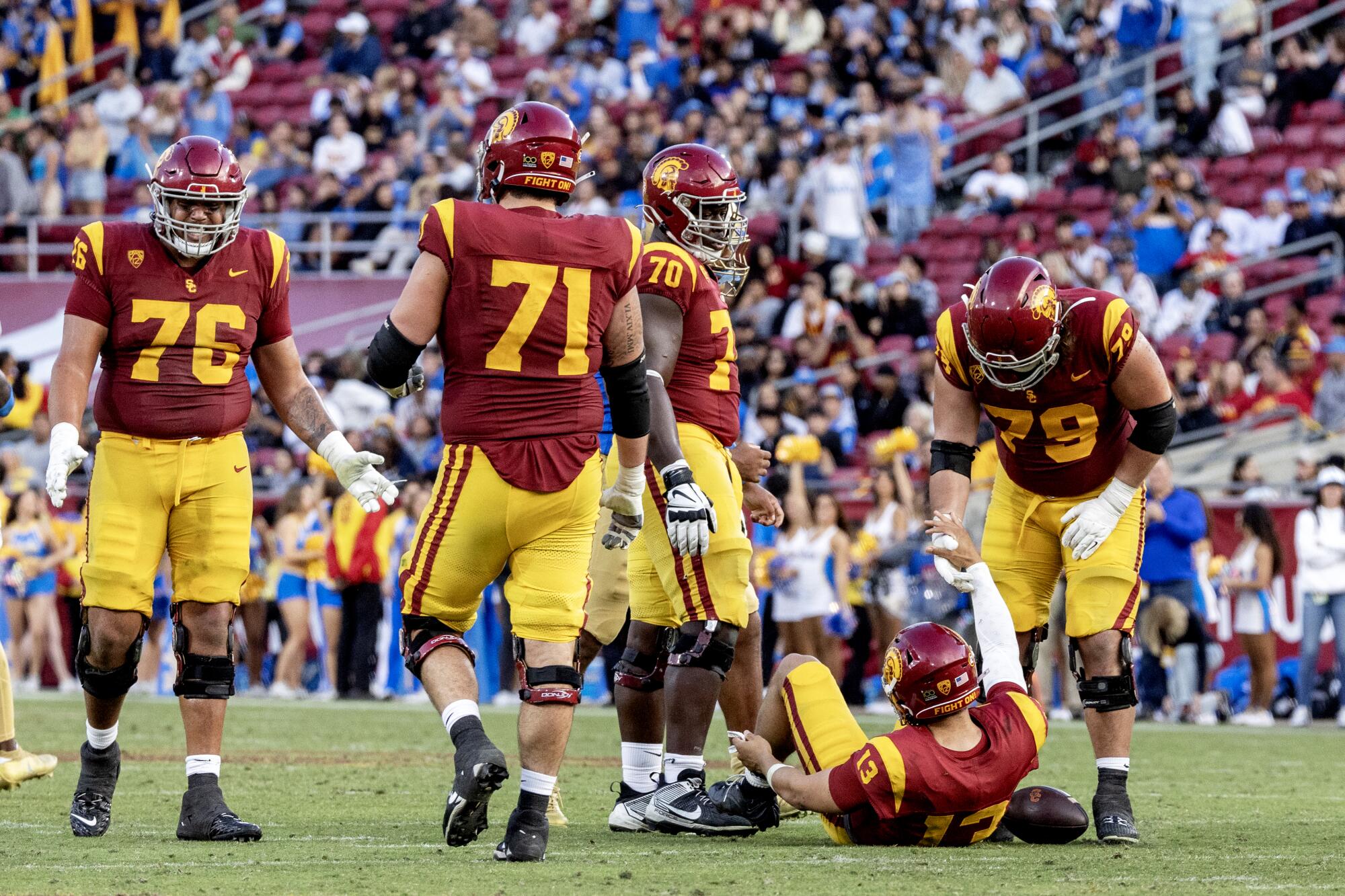
- Share via
The receiver parlayed his success into a first-round draft selection. The running back needed only eight games to run for a career-best season. The quarterback won the Heisman Trophy.
USC’s transfer portal scavenger hunts have yielded gems that shine brightest at the skill positions. Lincoln Riley’s attempts at fortifying the all-important lines of scrimmage have provided fool’s gold.
A disastrous second half of the season revealed just how far USC has to go to build a winning program up front as the Trojans lost five of their last six games.
USC touted newly built offensive and defensive lines with three and five new transfers, respectively, this season, but the Trojans (7-5, 5-4 Pac-12) have the Pac-12’s worst rushing defense and ranks 106th nationally in sacks allowed at 2.75 a game. Even as the transfer portal becomes every coach’s go-to roster Band-Aid, it has proven to be an insufficient solution to the most critical parts of the game: winning the line of scrimmage.
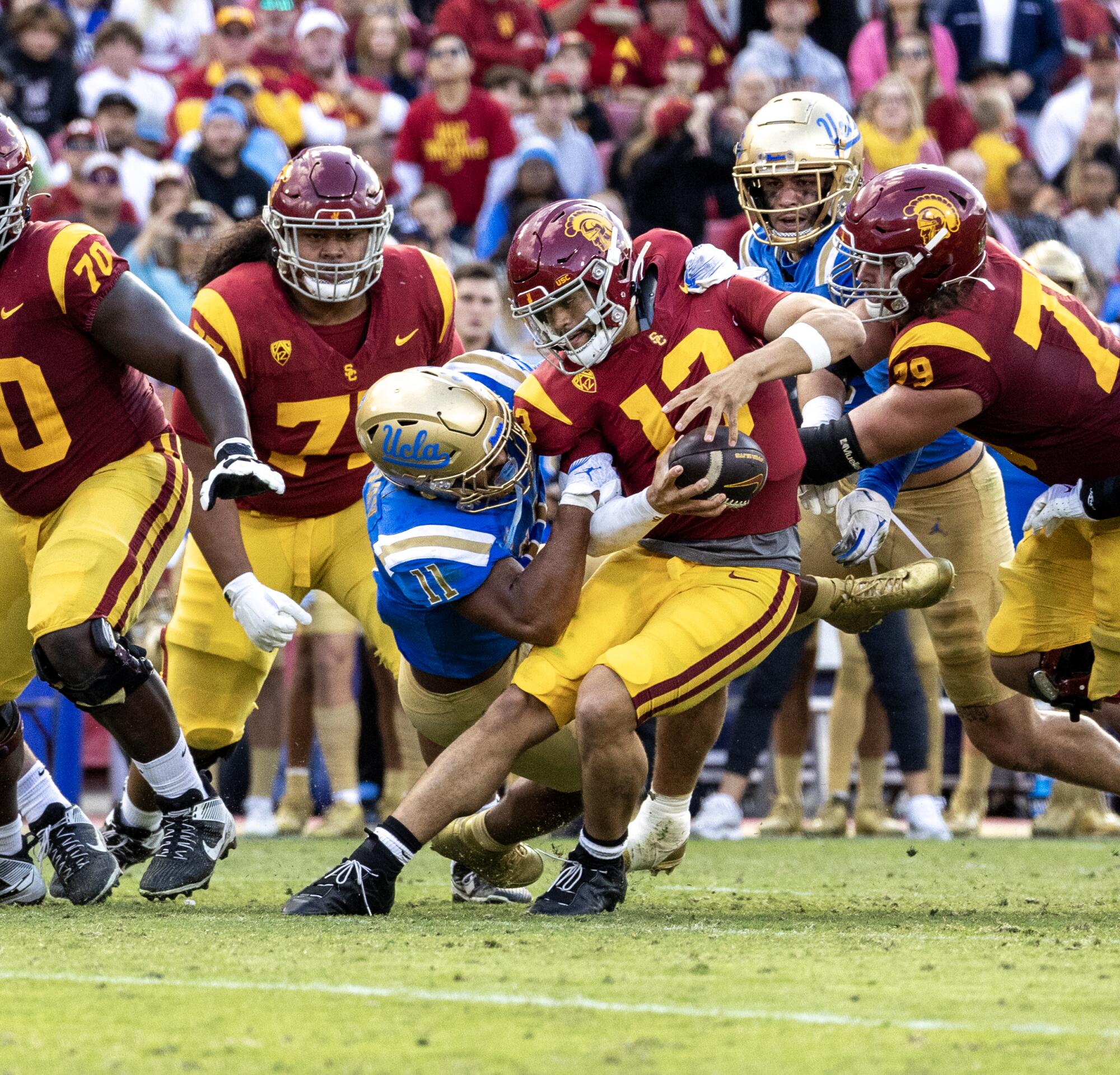
“It’s really more miss than it is hit,” said Geoff Schwartz, a Fox Sports and Sirius XM football analyst.
USC and Colorado each tried to fill three starting offensive line positions with first-year transfers this year, the most for any Pac-12 team. After the Buffaloes (4-7, 1-7) gave up seven sacks to UCLA this season, head coach Deion Sanders added another viral sound bite to his first season in Boulder by telling reporters he would “go get new linemen.”
Conversely, Oregon, Washington and Oregon State — the three Pac-12 teams named as semifinalists for the Joe Moore Award, which honors the nation’s most outstanding offensive line — have one first-year transfer in their combined starting lineups. Oregon’s Ajani Cornelius jumped from Rhode Island into the starting right tackle position for the Ducks, who lead the country in fewest sacks allowed per game at 0.45.
USC has struggled in the second half of games and the Trojans were unable to mount a comeback once again Saturday in a 38-20 loss to UCLA.
Oregon’s cohesive offensive line stonewalled a sagging USC defensive line that was supposed to be the team’s strength after loading up on Power 5 transfers. Anthony Lucas (Texas A&M), Jack Sullivan (Purdue) and Kyon Barrs (Arizona) have 5.5 tackles for loss combined and one sack.
Lucas, a towering 6-foot-5, 265-pound sophomore whose “freaky build” caused fits for offensive linemen during the preseason, hasn’t had more than three tackles in a game this season, setting the benchmark in the season opener against San José State. His quiet season can be attributed to the breakthrough of Solomon Byrd (11 tackles for loss, six sacks) and Georgia State transfer Jamil Muhammad, defensive line coach Shaun Nua said, but Lucas is “going to be a special one for us.”.
Lucas is part of the competitive depth the Trojans wanted to add this season, but the moves fell short of providing many competitive plays on the field. Muhammad, who has 10 tackles for loss and six sacks, and former Georgia defensive tackle Bear Alexander were the only first-year defensive front-four transfers to make an immediate impact.
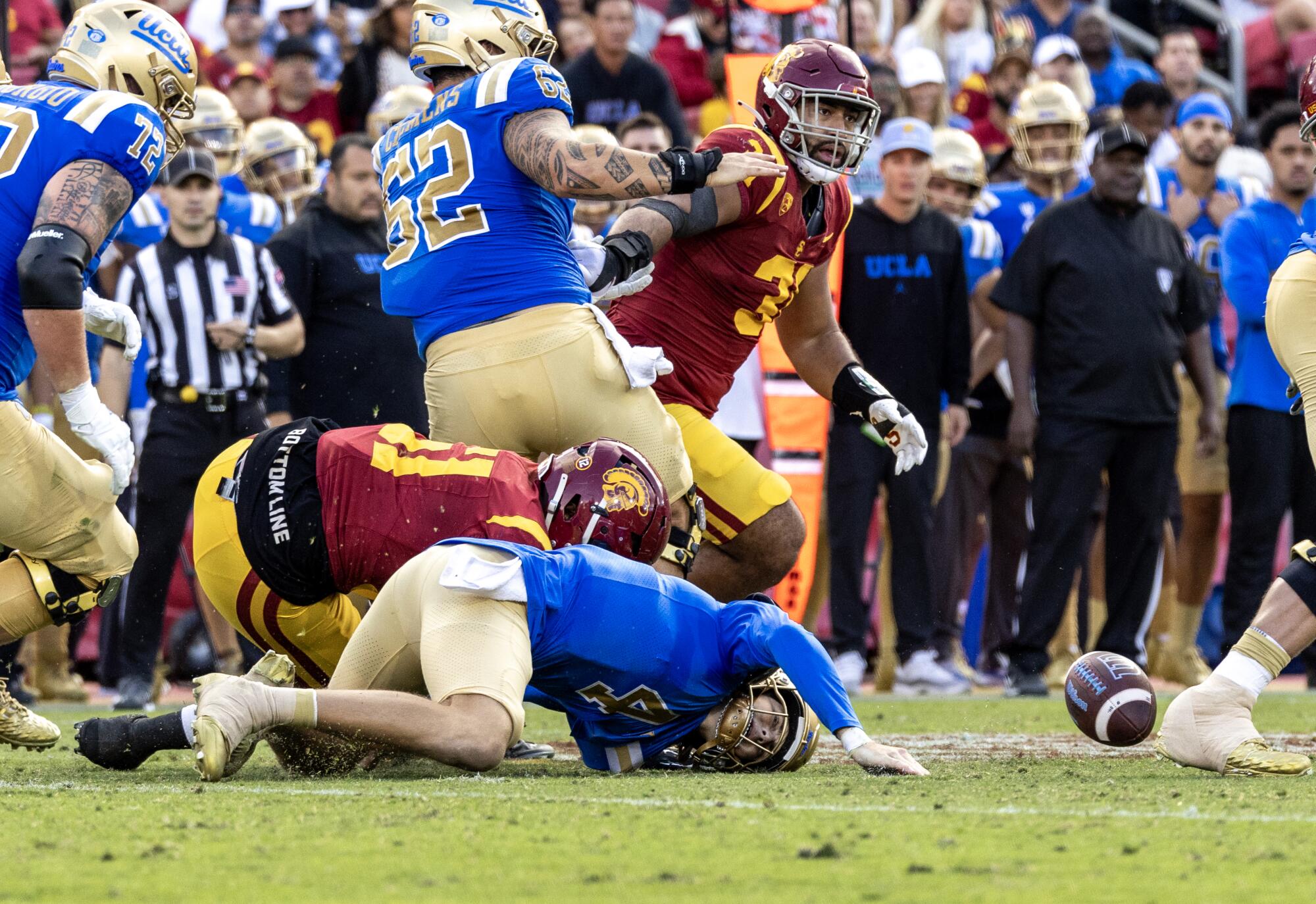
“I’m happy that we do have the depth that we have, but at the end of the day we’re not having the season defensively that we want,” said Nua, who was named co-interim defensive coordinator after Alex Grinch was fired. “So we can get all the best players here, but if we don’t help them get into a position to execute then it doesn’t do any of us any good.”
USC’s struggles in the trenches were on full display during a 36-27 loss to Oregon, after which Riley acknowledged the Ducks “played better on the line of scrimmage than we did.” Quarterback Caleb Williams was pressured on seemingly every play, requiring the same fleet-footed magic that helped him win the Heisman to limit Oregon to three sacks.
The protection breakdowns were a theme for an offensive line that tried to replace three starters with quick-fix transfers. Adding Jarrett Kingston (Washington State), Emmanuel Pregnon (Wyoming) and Michael Tarquin (Florida) did not go as smoothly as some of Riley’s skill position stars like receiver Jordan Addison’s success last season or running backs Travis Dye and MarShawn Lloyd.
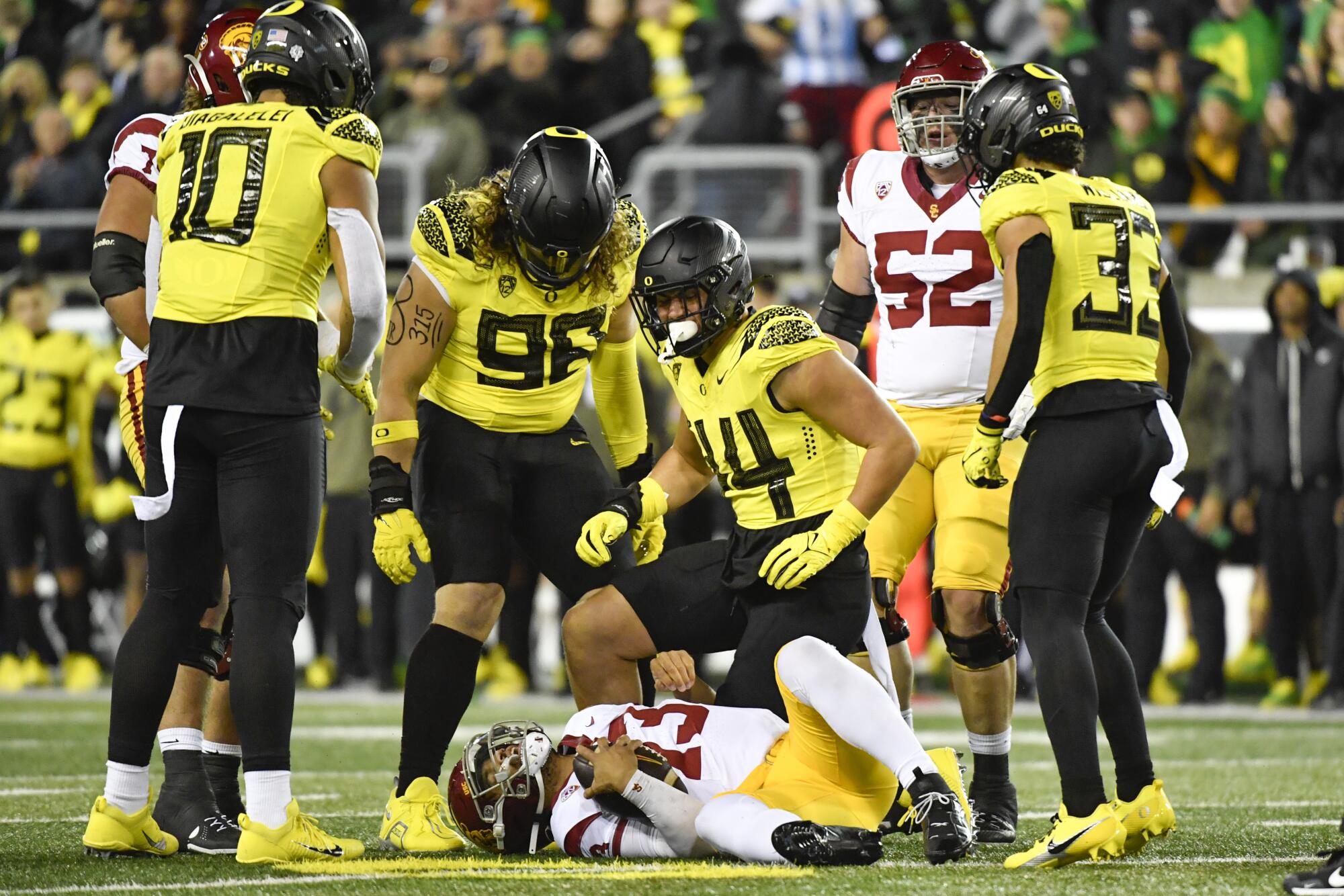
Tarquin, who started 20 games in four years at Florida, claimed the starting right tackle position but was bumped to a reserve role after USC gave up six sacks to Notre Dame. Kingston, who was in a battle for the starting role with Gino Quinones before Quinones suffered a season-ending leg injury, shifted from right guard to right tackle. Redshirt sophomore Mason Murphy slid into the starting lineup.
Integrating offensive line transfers requires a delicate hand. The smallest miscommunication can result in big losses. It’s not just a matter of identifying which player should block which defender and making the appropriate calls, said Schwartz, who was a three-year starter at right tackle for Oregon before an eight-year career in the NFL. It’s getting the conversations down to single-word calls that speed up the game.
“It just becomes a communication pattern where you understand exactly what the person next to you is doing, and the person next to you is doing, and the person next to you,” Schwartz said. “It becomes a situation where the trust and communication builds with reps.”
USC starting rush end Solomon Byrd is juggling a lot this season. The Wyoming transfer worked to get up to speed and is helping to lead USC’s defense.
Because of the unique chemistry required on the offensive line, Schwartz believes the strongest offensive lines must be built through high school recruiting, only using transfers sparingly on players who have been evaluated to fit perfectly into the scheme.
USC offensive line coach Josh Henson said “the biggest thing” the staff wants to do is build the offensive line by developing high school players. But the typical path has diminished in the age of the transfer portal.
Years ago, slender 6-foot-5 offensive linemen could easily get big-time offers as long as they could “bend and walk and chew gum,” said Chris Ward, the offensive line coach at Orange Lutheran and director/co-founder of a nonprofit group specializing in training offensive linemen in Southern California. During the portal era, those prospects are still playing Division I ball, but instead of Pac-12 offers they’re getting rerouted to Group of 5 teams. The compact, nimble 6-foot-2 linemen barely get looks, even if they star on their high school teams.
The logic goes that if a promising, but still untested, undersized prospect proves himself at a lower-level school, major programs like USC can swoop in the next year.
“Only the elite guys out of high school are getting their opportunities,” Ward said. “At least FBS-wide, they’re going to lean more on the transfer portal than the high school guys, but … that runs the risk of all the other things that happen with that, the jelling.”
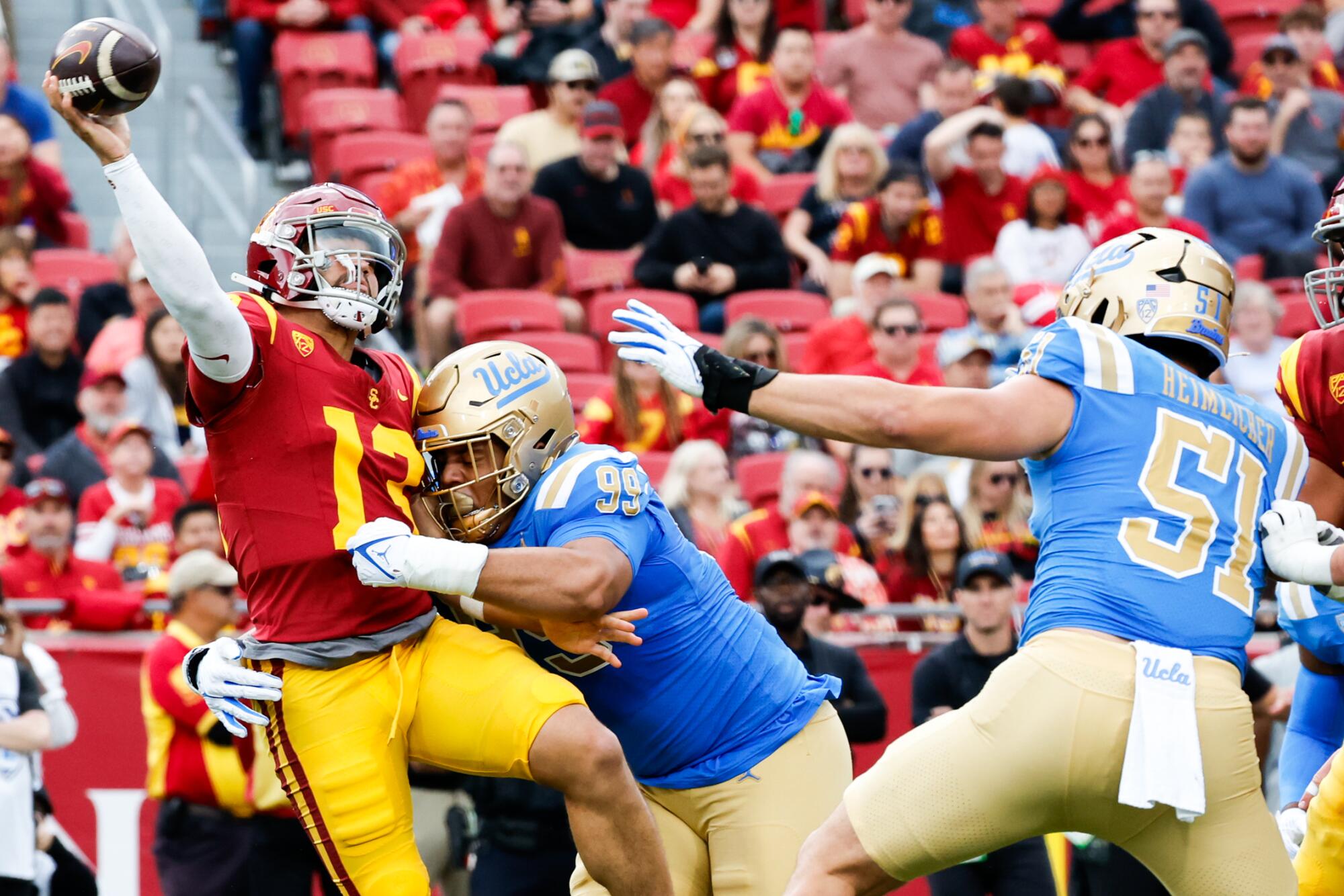
The Trojans signed six offensive linemen last year and former three-star prospect Alani Noa even started at left guard against San José State, becoming the first true freshman to start a season opener for the Trojans at that position since 2014.
On defense, former three-star lineman Elijah Hughes showed flashes of his potential during the nonconference season, with tackles against San José State and Nevada, and played in six games this year.
Immediate help could be slow arriving. Four-star Kameryn Fountain is USC’s only edge rusher commitment in the 2024 recruiting class and three-star Deyvid Palepale is the lone defensive lineman. With one month before the early signing period, USC has four offensive line commitments, led by four-star interior lineman Jason Zandamela from Clearwater (Fla.) Academy International, but the class is ranked just 18th in the country.
The lackluster recruiting has caused hand-wringing among USC fans eager to turn the page on Riley’s disappointing second season. But the coach reiterated that the road to the top of college football is long.
Lincoln Riley was supposed to transform USC back into a college football powerhouse. Instead, the Trojans are mired in mediocrity and it’s his fault.
“You don’t turn all that over, kinda from where this thing was, to all of a sudden being a big team [on] the offensive and defensive line,” Riley said after USC’s loss to Oregon. “That’s not gonna happen that fast.”
The Trojans are going to need to speed things up. Staying competitive in the Big Ten next season and beyond will demand it.
“The first and most important thing Lincoln needs to address are the lines,” former USC quarterback Matt Leinart tweeted during USC’s loss to UCLA. “Will get absolutely bullied in the Big 10 next year if there aren’t improvements ….drastic ones!”
While Riley has said last year’s team that went 11-3 and came within one game of the College Football Playoff semifinals was less talented than the current iteration that was effectively eliminated from playoff contention before November, USC’s current struggles underscore how underestimated last year’s offensive line was, Schwartz said.
The group, anchored by five-year starter Andrew Voorhees and four-year starting center Brett Neilon, was a semifinalist for the Joe Moore Award. It was a major breakthrough for an experienced unit that struggled through four offensive line coaches in five years.
Voorhees, Neilon and Justin Dedich, who started at right guard last season, had played together for five years. Tackles Jonah Monheim and Courtland Ford were in their third years with the tight-knit group. The only transfer addition was Virginia Tech’s Bobby Haskins, who started eight games at left tackle.
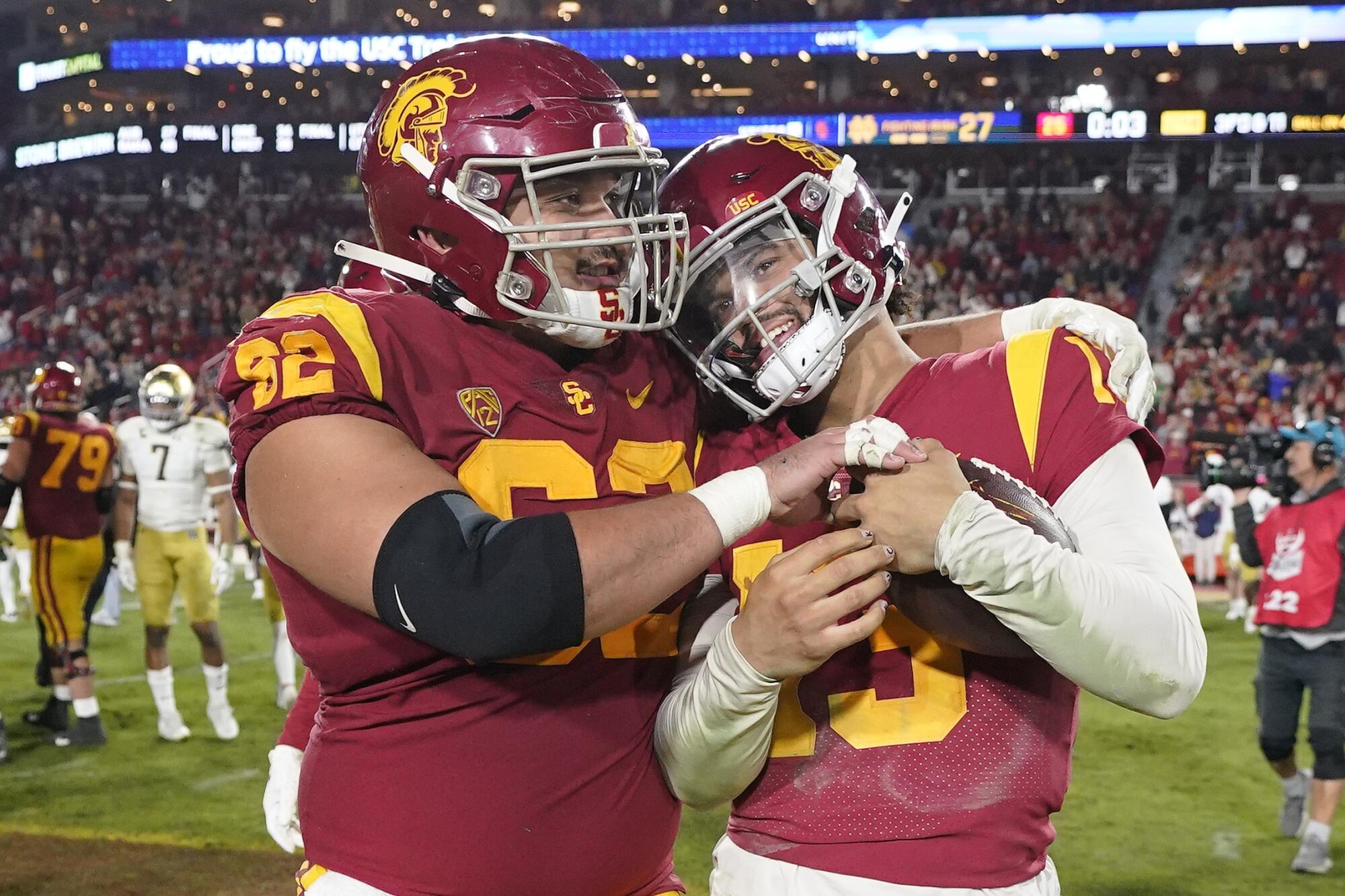
“You can’t buy that kind of brotherhood,” said Dedich, who shifted to center this season.
The redshirt senior spoke wistfully about the dynamic with his former teammates. But he perked up when thinking about an energetic meeting the offensive linemen had recently in which everyone was cracking jokes for 20 minutes. It felt like old times, Dedich said.
The Trojans hope it’s also the beginning of a new standard.
More to Read
Go beyond the scoreboard
Get the latest on L.A.'s teams in the daily Sports Report newsletter.
You may occasionally receive promotional content from the Los Angeles Times.

